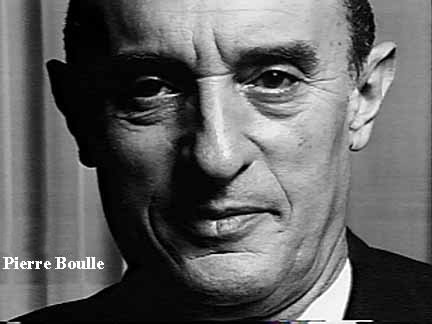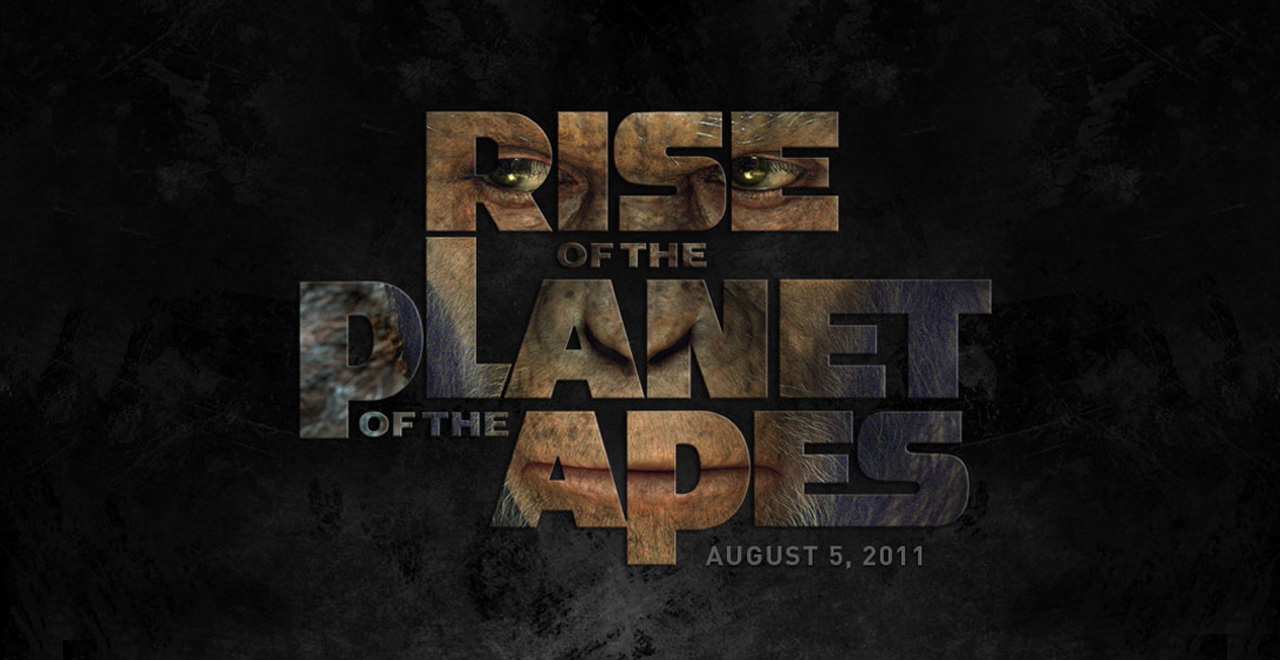If you are not familiar with The Planet of the Apes saga,
this post contains some big time SPOILER ALERTS.
The upcoming movie Rise of the Planet of the Apes
The original 1968 film, Planet of the Apes
The original Apes franchise was known for its use of the allegorical device of intelligent talking apes as means of making social commentary on issues like racial discrimination, animal rights, the legal system, religion and war, to name a few. The series’ penchant for social commentary goes right back to its original literary source material.
 |
| Boulle felt that his "monkey" novel was a lesser work all the way to the bank. |
The novel tells the story of a French journalist embedded on a space mission who ends up stranded alone on a planet where apes are the masters and humans the beasts. It bears more similarities to Jonathan Swift
 |
| The cover of this early edition nicely captures the book's satirical nature |
The novel set the stage for a basic concept of metaphorical and satirical social and political commentary that would, to one degree or another, inhabit the entire franchise in all of its future incarnations.
Fortunately, when Hollywood
Veteran Hollywood producer Arthur P. Jacobs
 |
| The O.Henry of TV writers |
Michael Wilson
In the film version, only the very basic premise of Boulle’s novel and the names of most of the ape characters remain (i.e.: Zira, Cornelius and Dr.Zauis). The French journalist becomes an American astronaut. For budget reasons, the apes’ modern day technological society became a more primitive Bronze Age
True to the allegorical nature of the book, Heston's naked trial scene at the hands of an ape tribunal, for instance, was a mix of allegories to the Scopes Monkey Trial
Then there is, of course, that Cold War
Planet of the Apes was released in 1968. It was a massive box office hit. Even in 1968, that meant that a sequel was inevitable. Heston wanted nothing to do with a sequel but did finally agree to cameo role. After passing on scripts by both Serling and Boulle himself, Jacobs settled on a screenplay by British writer Paul Dehn.
Beneath the Planet of the Apes
The apes soon follow; then there’s a lot of fighting and shooting. Finally a mortally wounded Heston activates the atomic bomb and blows up the entire world. Yes, the Apes movies were always kind of downer; the heroes are hunted and chased with no relief until the entire world is blown up. All this in the second movie of a big box office franchise, no less. Imagine Iron Man II
It was a very different pop culture landscape in 1970, that’s for sure.
So there we go. End of story. End of franchise.
Well, not really.
Beneath The Planet of the Apes came out in 1970 and was another huge hit. Fox decided they had a hit series of films on their hands and ordered Jacobs to make another Apes movie, leaving him to figure out how to make a sequel to a movie where the world was destroyed. Lucky for Jacobs, Dehn was a clever writer.
In the opening of the next film, Escape from the Planet of the Apes (
It is better not to think about that premise too much.
Hunter and McDowell reprise the roles of the apes Cornelius and Zira. The story of the apes in present day human society mirrors much of the plot of Boulle’s original novel. Like the human in Monkey Planet, the intelligent apes are treated as celebrities and embraced by human society. Like in the book, they are then eventually seen as a threat to civilization and hunted down. In the book, the French journalist finally escapes the planet. In the third Apes movie, the ape couple are hunted down and killed.
Yes. Killed. Along with their newborn baby, who is seen as the ultimate threat to the future of humanity. And you thought the end of the world was a downer ending.
The scenes of the two protagonist apes’ death especially showcase the dark nature of the Apes movies. And Escape from the Planet of the Apes is supposedly the comic relief “fish out of water” lighter outing of the franchise. Even so, the two main characters and their baby are shot and killed. Once again, imagine that in another big SF franchise. It would be like Star Trek IV: The Voyage Home
Only in the 70’s.
The series would get darker still in Conquest of the Planet of the Apes
Twenty years later, now in the year 1991, apes have become slaves to humans. Everybody remembers that from 1991, right? The big fads were , MC Hammer
Caesar, the intelligent ape baby has now grown up. He emerges from hiding and launches a revolution against his now crypto fascist human overloads. This time the film ends with the overthrow of all humanity. There are a couple of sympathetic exceptions but, really, the real heavies of this movie are the humans.
It’s hard to miss the allegories to the African American experience in the history of the United States. This is especially true during the many uprising scenes. The images of cops in helmets, holding armored shields while throwing tear gas into advancing apes also brings to mind the tumultuous youth rebellion of the era.
They even open fire on the crowd, just like at Kent State.
Caesar (as played by the same actor who played his dad, Roddy McDowell
Battle for the Planet of the Apes
Spoiler alert: it’s a rule that gets broken.
 |
| The Starsky and Hutch Fugitives on The Planet of the Ape |
The fifth film was followed by a 13 episode TV series
The producers of the first small screen Apes venture went to a guy who knew both Planet of the Apes and TV science fiction pretty well, Rod Serling. Though uncredited, the basic premise of the show and the characters were based on Serling's ideas. Sadly, the assignment would mark one of Serling's final TV jobs before his untimely death in 1975.
The show followed the adventures of two Starsky and Hutch
The model for the show was basically that of The Fugitive
The show did carry on the Apes tradition of social commentary, albeit in a more simplistic form. The commentary usually came in the form the morally and intellectually superior humans teaching the apes everything from how to hunt, farm and fish to basic physics to aviation to medicine to lessons in truth, justice and the American way. There was usually some kind of message about tolerance in there somewhere too. Benevolent Americans aiding the inhabitants of the socially, industrially and politically inferior Third World was the basic paradigm utilized in all 13 episodes.
The Apes TV series also presented something very significant in the franchise, something that had hardly been seen at all up to that point: optimism. Though not enough optimism to keep the show from being cancelled mid-season.
The optimism, however, would continue to grow in the animated series, Return to the Planet of the Apes
Interestingly, the Saturday morning cartoon
In Boulle's version, the intelligent human helps the primitive humans to escape from the apes. The humans then take up residence in a fortified camp and attempt to establish a new civilization. Serling's version added to that the humans discovering and subsequently utilizing old human weapons and technology like airplanes.
Those two elements made up most of the story arc of the series. Sadly, the show was cancelled before the continuation of that story arc ever made it to the screen (unless there's a comic book adaptation or some fan fiction out there somewhere I'm not aware of ).
The Apes animated series featured very limited animation and much of the writing was forced and clunky. Great ideas, not so great execution. If they have used those ideas in the live action show, with stronger writing, they may well have a hit TV show on their hands.
In addition to optimism the Apes animated series also brought something heretofore unseen in the franchise: empowerment. Up to that point the humans has always been portrayed as running, hiding, getting beaten up, shot, cut up and generally, well, losing every time to the apes. For the first time, the Apes series showed humans starting to get an upper hand over the apes. Ironically, Return to the Planet of the Apes also marked the decline and fall of the entire franchise.
Well, for about 30 years anyway.
An Apes revival had been in the works for many years after the end of the animated series. When Generation X
Finally, in 2001, Tim Burton
Burton's vision of the Ape society is interesting. In a rarity for the series, the apes actually take on some simian behavior (though no feces throwing, fortunately). The jungle-based ape city and the Kurosawa
There is certainly some social commentary in the film but the whole endeavor is lacking the gravitas and darkness that made the original films so memorable. In the first series, the Planet of the Apes is brought into being due ultimately to humanity's tragic flaws. In the 2001 version, the Planet of the Apes is brought into because Mark Wahlberg
That aside, Burton’s remake was released to disappointing critical and commercial success. Other than perhaps the success of the 1974 live action TV series in international markets outside of North America, no subsequent Apes property has lived up to the initial success of the Planet of the Apes box office phenomenon of 1968-73.
Nonetheless, Fox was still not content to just let a successful franchise sit on the shelf . As early as 2005, rumors of another Apes reboot started flying around the internet. This time it was said that the plan was to start the series over at the very origin of The Planet of the Apes itself. In other words, a remake of Conquest of the Planet of the Apes.
Originally titled simply Caesar
Younger stars like James Franco
Not surprising then, that Fox is giving the series another go. Though they are taking a few odd risks.
For some reason, Fox moved the release date up from November to August. This opens the film in and amongst many other big time summer blockbusters like Harry Potter
Remaking the fourth film of the series could be a risky commercial move too. Most audiences today are probably much more familiar with the original 1968 film or the even the 2001 remake. Awareness of the third sequel in the series does not seem to be as high in the mainstream.
The whole approach is certainly a gutsy move all around.
Who knows what will become of the social and political commentary that has become an intrinsic part of the Apes genre. The cautionary tale of nuclear Armageddon seems to be gone in favor of what seems to be a cautionary tale of genetic engineering. Social commentary today doesn’t play the way it did in the 60’s and early 70’s. Today, such undertones are often tempered with optimistic and upbeat endings, if they are there at all.
It is very unlikely that Rise of the Apes will end with Andy Serkis blowing up the world or with James Franco and Fried Pinto getting shot in the head. Without a similarly audacious downbeat ending or unflinching social commentary, it’s hard to say if, in fact, we will again witness a real Rise of the Planet of the Apes.
Should Rise of the Planet of the Apes fail, the series may want to take on a new motto:
"Ape shall not remake ape."









Caught the film last night. Not quite as much or the same type of social commentary as the original series but still a very good film, worthy of the franchise.
ReplyDelete